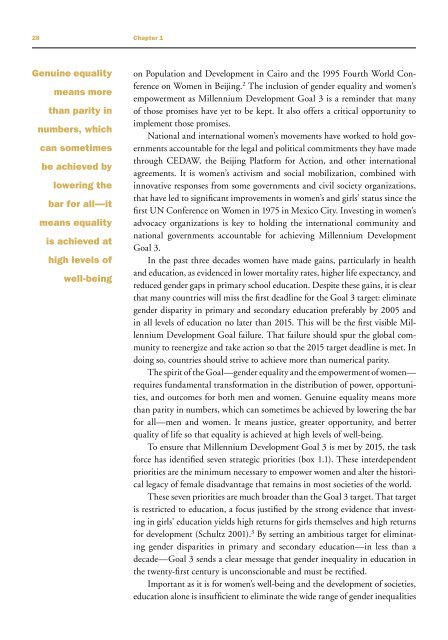Taking action: achieving gender equality and empowering women
Taking action: achieving gender equality and empowering women
Taking action: achieving gender equality and empowering women
Create successful ePaper yourself
Turn your PDF publications into a flip-book with our unique Google optimized e-Paper software.
28 Chapter 1<br />
Genuine <strong>equality</strong><br />
means more<br />
than parity in<br />
numbers, which<br />
can sometimes<br />
be achieved by<br />
lowering the<br />
bar for all—it<br />
means <strong>equality</strong><br />
is achieved at<br />
high levels of<br />
well-being<br />
on Population <strong>and</strong> Development in Cairo <strong>and</strong> the 1995 Fourth World Conference<br />
on Women in Beijing. 2 The inclusion of <strong>gender</strong> <strong>equality</strong> <strong>and</strong> <strong>women</strong>’s<br />
empowerment as Millennium Development Goal 3 is a reminder that many<br />
of those promises have yet to be kept. It also offers a critical opportunity to<br />
implement those promises.<br />
National <strong>and</strong> international <strong>women</strong>’s movements have worked to hold governments<br />
accountable for the legal <strong>and</strong> political commitments they have made<br />
through CEDAW, the Beijing Platform for Action, <strong>and</strong> other international<br />
agreements. It is <strong>women</strong>’s activism <strong>and</strong> social mobilization, combined with<br />
innovative responses from some governments <strong>and</strong> civil society organizations,<br />
that have led to significant improvements in <strong>women</strong>’s <strong>and</strong> girls’ status since the<br />
first UN Conference on Women in 1975 in Mexico City. Investing in <strong>women</strong>’s<br />
advocacy organizations is key to holding the international community <strong>and</strong><br />
national governments accountable for <strong>achieving</strong> Millennium Development<br />
Goal 3.<br />
In the past three decades <strong>women</strong> have made gains, particularly in health<br />
<strong>and</strong> education, as evidenced in lower mortality rates, higher life expectancy, <strong>and</strong><br />
reduced <strong>gender</strong> gaps in primary school education. Despite these gains, it is clear<br />
that many countries will miss the first deadline for the Goal 3 target: eliminate<br />
<strong>gender</strong> disparity in primary <strong>and</strong> secondary education preferably by 2005 <strong>and</strong><br />
in all levels of education no later than 2015. This will be the first visible Millennium<br />
Development Goal failure. That failure should spur the global community<br />
to reenergize <strong>and</strong> take <strong>action</strong> so that the 2015 target deadline is met. In<br />
doing so, countries should strive to achieve more than numerical parity.<br />
The spirit of the Goal—<strong>gender</strong> <strong>equality</strong> <strong>and</strong> the empowerment of <strong>women</strong>—<br />
requires fundamental transformation in the distribution of power, opportunities,<br />
<strong>and</strong> outcomes for both men <strong>and</strong> <strong>women</strong>. Genuine <strong>equality</strong> means more<br />
than parity in numbers, which can sometimes be achieved by lowering the bar<br />
for all—men <strong>and</strong> <strong>women</strong>. It means justice, greater opportunity, <strong>and</strong> better<br />
quality of life so that <strong>equality</strong> is achieved at high levels of well-being.<br />
To ensure that Millennium Development Goal 3 is met by 2015, the task<br />
force has identified seven strategic priorities (box 1.1). These interdependent<br />
priorities are the minimum necessary to empower <strong>women</strong> <strong>and</strong> alter the historical<br />
legacy of female disadvantage that remains in most societies of the world.<br />
These seven priorities are much broader than the Goal 3 target. That target<br />
is restricted to education, a focus justified by the strong evidence that investing<br />
in girls’ education yields high returns for girls themselves <strong>and</strong> high returns<br />
for development (Schultz 2001). 3 By setting an ambitious target for eliminating<br />
<strong>gender</strong> disparities in primary <strong>and</strong> secondary education—in less than a<br />
decade—Goal 3 sends a clear message that <strong>gender</strong> in<strong>equality</strong> in education in<br />
the twenty-first century is unconscionable <strong>and</strong> must be rectified.<br />
Important as it is for <strong>women</strong>’s well-being <strong>and</strong> the development of societies,<br />
education alone is insufficient to eliminate the wide range of <strong>gender</strong> inequalities

















